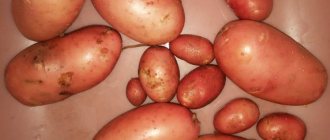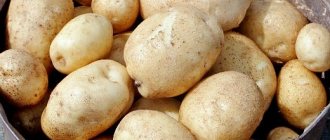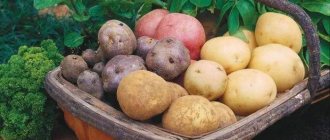History of variety selection
The Chaika potato was bred at a breeding station in the village of Falenki, Kirov region, Russia. The variety is the fruit of hybrid selection and was obtained by crossing two popular potato varieties - Kingston and Shurminsky 2. After state tests in 2005, Chaika was included in the State Register of the Russian Federation and allowed for zoning in many regions of Russia, mainly in the Volga-Vyatka and North-Western regions. In addition, the variety is perfect for growing in Ukraine and Moldova, thanks to the warm climate.
Did you know? To accustom the French to potatoes, agronomist Antoine-Auguste Parmentier came up with the idea of arranging enhanced security near the potato field. At night, when there was no security, intrigued locals began to steal and try unknown fruits.
Characteristics of the variety
The height of Chaika potato bushes is medium or high. The type of growth is erect, that is, the stem grows vertically for some time until it begins to bend down under its own weight. The plant is distinguished by large leaves of a rich green color. During flowering, the Chaika is covered with medium-sized white flowers. Each bush of the variety produces 6–11 potato tubers.
The fruits have a round-oval shape, their skin is smooth, yellowish, with medium and medium-deep eyes. The potato pulp is dense, soft creamy, with excellent taste. Contains 12–15% starch. The weight of mature tubers of the Chaika variety is usually in the range of 70–125 g.
Productivity
The variety has good yield - 242–414 c/ha (2.42–4.14 kg/m²). The maximum tuber harvest recorded for the Chaika variety was 454 c/ha.
Important! According to folk superstitions, the period of planting potatoes coincides with the beginning of bird cherry flowering or the appearance of leaves on a birch tree.
Ripening time
The variety belongs to the mid-late variety, since its growing season is 120 days. Thus, when planting in May, harvesting can be planned for early September.
Variety resistance to diseases
The variety is resistant to viral diseases of the crop and potato cancer. However, it is more susceptible to late blight than many other hybrids. Also, sometimes plants are affected by scab.
Video about the variety “Chaika”
Unfortunately, there is no video for this variety at the moment. We invite you to watch the video section of our website, where other videos about potatoes and other agricultural crops are posted. We and the entire farming community will be grateful if you send us your video or link about this variety from YouTube or any other video hosting service. If you see this message, it means that we have not yet been able to find a suitable video for this variety.
Similar articles:
Potatoes and all its varieties in detail here → Potato variety “Inspiration” - description characteristics reviews photo video
Potatoes and all its varieties in detail here → Potato variety “Belousovsky” - description characteristics reviews photo video
Potatoes and all their varieties in detail here → Potato variety “Blakit” - description characteristics reviews photos video
Potatoes and all their varieties in detail here → Potato variety “Bafana” - description characteristics reviews photos video
Potatoes and all their varieties in detail here → Potato variety “Bryansk reliable” - description characteristics reviews photos video
Caring for potatoes after planting
The Seagull should be watered in the morning or evening. This event should not be carried out too often, focusing on the temperature and humidity of the surrounding air. As a result, the soil on the site should be moist, but not too wet or dry. The potato root system, compared to other crops, especially needs air.
Therefore, after each watering it should be loosened. In hard or water-logged soil, the tubers will begin to “suffocate.” The first loosening of the soil is carried out 5-6 days after planting, even before the first shoots appear. At the same time, weeds are destroyed so that they do not have time to take root.
Learn how to properly water potatoes yourself.
The first time you need to hill up potatoes is when the height of the plants has reached 12–15 cm. Hilling is carried out after watering, after which the beds are irrigated again. The next hilling is approximately 3 weeks after the first manipulation.
Potatoes definitely need additional feeding. It is introduced in several stages:
- in the fall, after harvesting - phosphorus and potash fertilizers;
- in the spring, during planting - organic fertilizers;
- in the spring, during the period of germination of bushes - nitrogen fertilizers;
- during active growing season - complex fertilizer compositions.
We advise you to familiarize yourself with the features of applying fertilizers for potatoes when planting.
An important stage of plant care is the fight against diseases and pests. The most common pests of the variety are the Colorado potato beetle and the golden potato cyst nematode. Therefore, when planting the Chaika variety, you should take care of standard preventive measures. To get rid of nematodes, you should regularly loosen the soil around the plants. Effective systemic drugs (“Masterpiece”, “Prestige”) or safer biological ones (“Bitoxibacillin” and others) help well against the Colorado potato beetle.
Treatment with a fungicide will help get rid of scab, and spraying with an aqueous solution of copper sulfate will help to get rid of late blight.
Planting and growing potatoes
Before planting this crop, you should choose the right site and prepare planting material.
Features of planting and caring for potatoes of the Melodiya variety
Optimal planting dates
Potatoes should be planted in warm, well-heated soil. Therefore, if night frosts are still observed in your area, you should wait a little. If you plant Chaika in cold soil, the tubers will “sit” in the ground for a long time. Do not plant seeds in soil that is too wet, as this may cause them to rot. Overexposure to planting material is also dangerous; the soil may become too hot and dry, which will increase the likelihood of a low yield. Typically, the Chaika variety is planted in May.
The main signs of readiness for this event:
- no return frosts;
- the weather forecast shows a future warm period;
- the ground at a depth of 10–12 cm warmed up to +8°C.
You will be interested to learn about the technology of growing potatoes in bags and boxes.
Crop rotation rules
Potatoes can grow in one area for no more than 3 years. Its peculiarity is that the tuber absorbs a large amount of potassium and phosphorus from the soil, so after harvesting, appropriate mineral fertilizers should be added to the ground. And be sure to remove plant debris so that it does not cause contamination of the soil and other crops with various pathogens. If it is not possible to change the planting site, measures should be taken to disinfect and restore soil fertility.
These include:
- sowing early ripening green manure followed by incorporation into the soil;
- deep digging of the site after harvesting with a full rotation of the layer;
- spring digging with the application of mineral and organic fertilizers;
- introducing ash into the soil for disinfection and activation of crop growth.
Read more about what is best to plant after potatoes.
After potatoes, you should not plant other nightshades - tomatoes, peppers, eggplants, as well as strawberries and wild strawberries. But in this area, zucchini, legumes, pumpkin, cabbage, cucumbers, onions and garlic will do well. If a former potato plot is planted with oats, rye or lupine, then these plants will restore the lost balance of nutrients. It is very important to consider what plants are nearby. Experience has shown that potatoes are “friends” with eggplant, corn, cabbage, onions, horseradish and spinach. Beans will be an excellent neighbor, as they will “treat” him with nitrogen and protect him from the Colorado potato beetle. But cucumbers, tomatoes and pumpkins do not respond very well to proximity to this crop.
Soil requirements
The place chosen for planting potatoes must have fertile, light soils with good permeability. The most suitable soils will be chernozem, soddy-podzolic soils and cultivated peatlands. It is optimal if the soils are slightly acidic.
Important! Heavy and clayey soil is not suitable for potatoes. Plants develop slowly in it, and potatoes grow small and irregular in shape.
Preparation of planting material
Correct and timely preparation of planting material will trigger biological processes in the tubers associated with the formation of sprouts and the development of the root system. In addition, at the preparation stage, sick or weak specimens are removed. Preparations for the landing should begin about a month before the event itself. To do this, you should move the tubers from the storage place (basement or cellar) to a warmer and more lit room, spread them out in 1-2 layers on the floor or in any container. The optimal temperature regime is +18...+20°C in the first 10-12 days to awaken the eyes and +10...+14°C further so that the sprouts do not overgrow and become too elongated. The goal of germination is to obtain tubers with strong, healthy sprouts, which will accelerate the emergence of seedlings and, accordingly, improve yield. The duration of germination is, on average, 20–40 days. If for some reason there was no time to prepare the tubers, you can warm up the planting material at least 3-4 days before planting. This will “awaken” the seed material.
Did you know? Before the appearance of potatoes in Rus', the main vegetables in the diet were turnips and rutabaga. However, people gradually appreciated the new product, especially since up to a dozen new potatoes can be grown from one tuber.
Harvest and storage
The first potatoes can be harvested in July, when the bushes have faded and the leaves have begun to fade a little. To begin with, you can dig up one bush and, if the tubers have reached a size of 3 cm, you can already try the new potatoes. However, the variety will only fully ripen by September, when the main harvest takes place. When harvesting, each bush is carefully dug up from the side with a pitchfork, then pulled out by the tops, the tubers are removed and placed in a bucket or other container.
Before storing, the fruits are sorted, bad or rotten ones are removed, and those that are too small and with mechanical damage are set aside for quick use. Planting material for the next season is also sorted separately.
We recommend finding out whether potatoes need to be washed before storing.
Typically, potatoes are stored in clean wooden boxes in a dry, dark and cool room - a cellar, basement or pit. In order for air to circulate freely, the containers must be placed on stands and not leaned tightly against the wall. The optimal storage temperature is +2…+4°C. Thanks to the highest level of shelf life - up to 92% - the variety is ideal for creating reserves for the winter. Despite this, it is worth checking vegetables periodically (once every 3-4 weeks), throwing out rotten specimens.
The Chaika variety has deservedly gained great popularity in our country. It not only pleases with its unpretentiousness and productivity, but also with aromatic, delicious potato dishes - mashed potatoes, casseroles, chips and many others.











